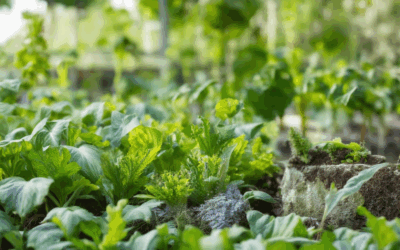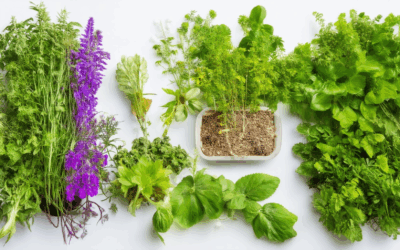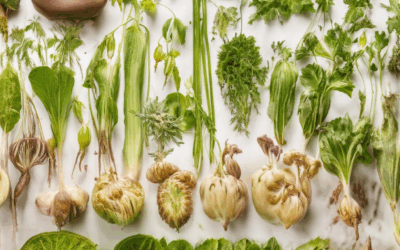Are you eager to take proactive steps toward combating climate change while creating a beautiful and sustainable outdoor space? Imagine transforming your yard into a haven for biodiversity and a powerful tool in the fight against global warming—by practicing carbon-neutral gardening. By strategically planting the best carbon-sequestrating plants, you can actively remove harmful CO2 from the atmosphere, contribute to a healthier environment, and reduce your overall carbon footprint. Whether you’re an urban gardener or someone with land, the possibilities for creating a carbon-neutral garden are vast and accessible. This guide delves into the essential practices, top plants, and sustainable methods to get started, ensuring your garden becomes a thriving carbon sink while enhancing your surroundings.
Carbon Gardening
Carbon gardening is an environmental strategy that focuses on planting gardens and managing land to capture and store carbon dioxide from the atmosphere. This process helps mitigate the effects of climate change by reducing greenhouse gases and promoting sustainable land management.
Key Components of Carbon Gardening
- Selecting Plants: Choose plants known for their ability to sequester carbon, such as trees, shrubs, and perennials. Trees are particularly effective due to their deep root systems which can pull CO2 from the air and store it in their tissues.
- Soil Health: Healthy soil plays a crucial role in carbon sequestration. Practices like crop rotation, cover cropping, and organic amendments can enhance soil fertility and its ability to store carbon.
- Composting: Adding compost to your garden can increase soil organic matter, which binds carbon and stores it in the ground. This practice also improves soil structure and plant growth.
- Agroforestry: Integrating trees with crops and livestock can create a more resilient ecosystem. This approach enhances carbon storage through tree planting and manages resources efficiently.
Case Studies and Examples
Many communities and individuals have successfully implemented carbon gardening practices. For instance, certain urban farms and community gardens have reported significant increases in carbon sequestration through tree planting and sustainable farming methods. These initiatives often collaborate with local organizations to maximize their impact.
Community Involvement
Carbon gardening isn’t just an individual effort—it thrives on collective action. Local governments, schools, and NGOs often partner to create educational programs, tree-planting campaigns, and community gardens. Engaging neighbors and sharing knowledge can amplify the benefits of carbon gardening on a broader scale.
Ongoing Efforts and Challenges
While carbon gardening offers a promising solution to climate change, challenges remain. Limited awareness, funding, and access to resources can hinder widespread adoption. However, ongoing efforts by organizations like Old Seed aim to provide education, resources, and support to promote sustainable practices and carbon sequestration through gardening.
By adopting carbon gardening techniques, individuals and communities can contribute to a healthier planet while enjoying the benefits of beautiful, productive landscapes.
Reducing Carbon Footprint in Gardening
Gardening can have a significant environmental impact, but with mindful practices, we can minimize its carbon footprint. Here are some effective strategies:
- Electric Tools: Replace gas-powered lawn mowers and trimmers with electric models. Electric tools emit fewer greenhouse gases and require less maintenance.
- Manual Tools: Use rakes, brooms, and other manual tools for smaller tasks to eliminate the need for gas-powered equipment.
- Drip Irrigation: Install drip irrigation systems to conserve water and reduce the energy used for watering.
- Composting: Start composting kitchen scraps and yard waste to create nutrient-rich soil amendments, reducing the need for synthetic fertilizers.
- Native Plants: Plant native vegetation suited to your region, as they require less water and maintenance, and support local wildlife.
- Tree Planting: Incorporate trees and shrubs into your garden to act as carbon sinks, absorbing CO2 and improving air quality.
- Mulching: Apply thick layers of organic mulch to retain soil moisture, reduce weed growth, and regulate soil temperature.
- Sustainable Pest Control: Use organic pesticides and herbicides, such as neem oil or compost teas, to protect your garden while minimizing harm to the environment.
- Eco-Friendly Transportation: Opt for carpooling, public transportation, or delivery services when purchasing gardening supplies to reduce transportation-related emissions.
- Heirloom Seeds: Choose heirloom or open-pollinated seeds to grow plants that are more resilient and adapted to local conditions, reducing the need for inputs.
By adopting these practices, you can create a more sustainable and eco-friendly garden while contributing to a healthier planet. Explore more tips and resources on sustainable gardening at Old Seed .
How to Make a Carbon Neutral Farm
To create a carbon-neutral farm, implement a combination of sustainable practices that reduce greenhouse gas emissions while enhancing carbon sequestration. Here’s a step-by-step guide:
-
Adopt Conservation Tillage : Minimize tillering to reduce soil disturbance and carbon release. Use equipment that preserves soil structure and organic matter.
-
Implement Crop Rotation : Rotate crops to optimize carbon absorption. Legumes like alfalfa and clover are ideal as they fix nitrogen, reducing reliance on synthetic fertilizers.
-
Practice Cover Cropping : Grow cover crops such as clover, rye, or vetch. These plants protect soil, reduce erosion, and contribute to carbon sequestration through photosynthesis.
-
Integrate Agroforestry Practices : Plant trees around fields to provide shade, cooling the soil and absorbing CO2. Consider planting 100-200 trees per acre depending on local conditions.
-
Enhance Soil Health : Apply compost regularly to boost soil organic matter and sequester carbon. Avoid synthetic fertilizers to minimize nitrous oxide emissions.
-
Adopt Integrated Pest Management (IPM) : Use biological controls and natural predators to manage pests, reducing the need for chemical pesticides.
-
Leverage Livestock Responsibly : Keep livestock on perennial pastures and practice rotational grazing to minimize feed requirements and reduce emissions associated with animal husbandry.
-
Optimize Water Management : Install efficient irrigation systems like drip irrigation and rainwater harvesting to conserve water and reduce energy use.
-
Prioritize Carbon Sequestration : Plant native trees and shrubs on unused land or along field edges to capture and store CO2.
-
Sell Locally : Access local markets, farmers’ unions, or CSA programs to reduce transportation emissions by selling directly to nearby consumers.
-
Engage the Community : Host workshops or events to educate neighbors and promote collective efforts toward carbon reduction.
By systematically implementing these practices, you can significantly reduce your farm’s carbon footprint while fostering a more sustainable environment.
What is the Most Efficient Carbon Capture Plant?
Carbon capture plants are organisms that play a crucial role in removing CO2 from the atmosphere through photosynthesis. Their efficiency depends on various factors, including their photosynthetic rate, growth habits, and lifespan. Below are some of the most efficient carbon-capturing plants:
1. Live Oak
The live oak is often considered one of the most efficient carbon-capturing trees due to its ability to sequester significant amounts of CO2 over its long lifespan. On average, a live oak can store approximately 10,994 CO2 equivalent over its lifetime.
2. East Palatka Holly
Next on the list is the East Palatka holly, which has a documented carbon fixation rate of 7,321 CO2 equivalent during its lifetime. This plant is known for its resilience and ability to thrive in diverse environmental conditions.
3. Mangrove Trees
Mangrove trees are highly efficient carbon capturers, particularly in coastal areas. These trees can sequester up to 1,800 pounds of CO2 per acre annually, making them invaluable for protecting shorelines and enhancing biodiversity.
Key Factors Influencing Efficiency
- Photosynthetic Rate: Plants with higher photosynthetic rates tend to capture CO2 more efficiently. Some species, like certain varieties of bamboo, have exceptionally high rates.
- Growth Habits: Fast-growing plants, such as poplars and willows, are often better at capturing CO2 compared to slower-growing species.
- Lifespan: Long-lived plants generally have more time to accumulate carbon, making them more efficient over the long term.
Practical Applications
Planting carbon-capturing species can contribute to reforestation efforts, urban green spaces, and agroforestry practices. For instance, Miscanthus grass, a type of bamboo, is widely used in bioenergy applications due to its high carbon sequestration capacity and rapid growth.
By incorporating these plants into our landscapes and ecosystems, we can effectively combat climate change while creating sustainable habitats for wildlife.
Learn more about sustainable gardening practices and carbon-capturing plants at Old Seed.
What Plant Absorbs the Most CO2 Per Year?
Bamboo stands out as one of the most efficient plants for absorbing CO2, capable of capturing up to 60 tons of CO2 per hectare annually. Its rapid growth rate and extensive root system make it highly effective in carbon sequestration.
- Bamboo: Known for its high photosynthetic rate, bamboo captures 5 times more CO2 than an equivalent area of trees and produces 35% more oxygen.
- Redwoods: These fast-growing trees are excellent carbon sinks, storing significant amounts of CO2 in their wood and contributing to reforestation efforts.
- Mangrove Trees: Found in coastal areas, mangroves are highly efficient at capturing CO2, making them vital for coastal blue carbon ecosystems.
- Saguaro Cactus: In arid regions, saguaro cacti store carbon in their trunks, contributing to desert carbon sequestration efforts.
- Seagrasses: These marine plants act as effective carbon sinks, playing a crucial role in marine carbon capture.
These plants, along with others like those in the Amazon rainforest, collectively play a vital role in combating climate change by absorbing large quantities of CO2 and contributing to global carbon sinks.
How Much Does It Cost to Build a Carbon Capture Plant?
Building a carbon capture plant involves significant investments due to the complexity and emerging nature of the technology. Current estimates suggest that the cost ranges between $300 to $600 per ton of CO2 captured , depending on the scale, location, and specific technology employed. Recent advancements have led to a decline in costs, with projections indicating that future plants could operate below $100 per ton .
Key factors influencing costs include:
-
Technology and Scale : Larger facilities benefit from economies of scale, reducing per-ton costs. Different methods, such as using amines or other capture technologies, may have varying expense structures.
-
Government Incentives : Subsidies, tax credits, and grants can significantly lower initial costs. Regions with supportive policies, like California, have seen active projects.
-
Location and Infrastructure : Access to industrial emissions sources and suitable storage locations can impact overall expenses.
-
Operational Efficiency : Consideration of lifecycle costs, including maintenance and operations, affects the feasibility of long-term investments.
As technology advances and adoption increases, costs are anticipated to decrease, fostering wider implementation of carbon capture solutions.








0 Comments